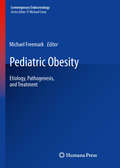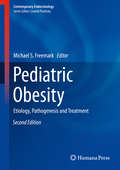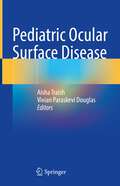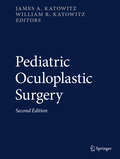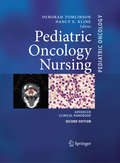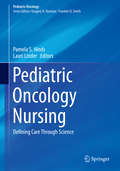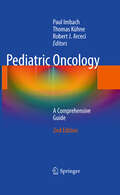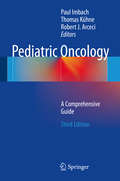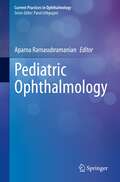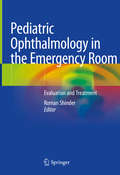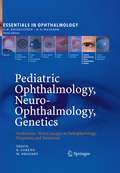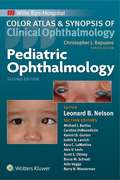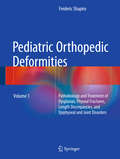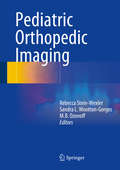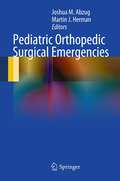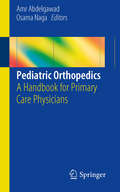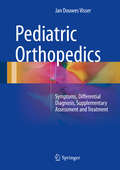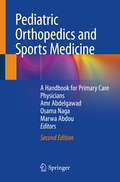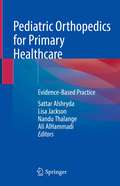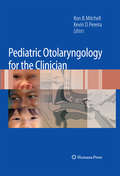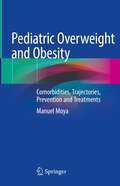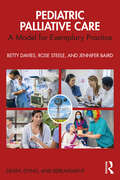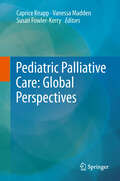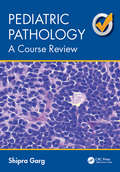- Table View
- List View
Pediatric Obesity
by Michael FreemarkChildhood obesity and its co-morbidities -- including type 2 diabetes, hypertension, dyslipidemia, sleep apnea, and fatty liver disease -- have seen striking increases in recent years. Despite a wealth of investigation, there is considerable controversy regarding the etiology of childhood obesity and the optimal approaches for prevention and treatment. Pediatric Obesity: Etiology, Pathogenesis, and Treatment addresses the controversy with a range of features that make it a unique resource for those who care for obese children and their families. Written from a perspective that is international in scope, the distinguished authors re-assess the roles of genetic and environmental factors in the pathogenesis of childhood obesity and critically review new studies of the effects of lifestyle, pharmacologic, and surgical interventions. The evidence-based approach of Pediatric Obesity: Etiology, Pathogenesis, and Treatment provides a comprehensive and invaluable guide for all healthcare providers concerned with the evaluation and care of children with nutritional and metabolic disease and with the societal implications of the obesity epidemic.
Pediatric Obesity
by Michael S. FreemarkChildhood obesity and its co-morbidities -- including type 2 diabetes, hypertension, dyslipidemia, sleep apnea, and fatty liver disease -- have seen striking increases in recent years. Despite a wealth of investigation, there is considerable controversy regarding the etiology of childhood obesity and the optimal approaches for prevention and treatment. Pediatric Obesity: Etiology, Pathogenesis, and Treatment addresses the controversy with a range of features that make it a unique resource for those who care for obese children and their families. Written from a perspective that is international in scope, the distinguished authors re-assess the roles of genetic and environmental factors in the pathogenesis of childhood obesity and critically review new studies of the effects of lifestyle, pharmacologic, and surgical interventions. The evidence-based approach of Pediatric Obesity: Etiology, Pathogenesis, and Treatment provides a comprehensive and invaluable guide for all healthcare providers concerned with the evaluation and care of children with nutritional and metabolic disease and with the societal implications of the obesity epidemic.
Pediatric Occupational Therapy Handbook: A Guide to Diagnoses and Evidence-based Interventions
by Patricia Bowyer Susan M. CahillCombining essential assessment guidance with the latest evidence-based intervention strategies, this compact reference helps you quickly locate the information you need to evaluate and manage pediatric disorders. <p><p>Access diagnosis-specific information on epidemiology, precautions, and more, as well as suggested interventions supported by the latest research, all in a convenient, pocket-sized handbook perfect for the busy clinical setting. Information is presented in a consistent format for easy reference and complies with the OT Practice Framework to help you ensure the most effective therapeutic outcomes.
Pediatric Ocular Surface Disease
by Aisha Traish Vivian Paraskevi DouglasOcular surface diseases in children have not always been well understood and the literature in this age group is limited. The consequences of misdiagnosis and delayed diagnosis include visually significant scarring and amblyopia, thus with real impact on their quality of life and ultimate visual potential. Recently, there has been an increase in clinical and research focus on these diseases, contributing to a growing awareness of their importance to pediatric visual health. This book is the first comprehensive volume dedicated to pediatric ocular surface diseases. It provides an up-to-date and highly illustrated discussion of the pathophysiology, symptomatology and diagnostic and therapeutic strategies of these less commonly understood diseases, in a format that is readily absorbed by trainees and seasoned physicians alike. The aim of this book is to provide a practical and detailed understanding of ocular surface disease in the pediatric population, as many of these corneal conditions in children require unique therapeutic approaches and may have subtle presentations. Chapters will address key issues, such as dry eye disease, Steven Johnson Syndrome and neurotrophic keratitis, that can have a profound impact on children’s visual and social development. Pediatric Ocular Surface Disease is a must-have resource for pediatric ophthalmology fellows, cornea fellows, pediatric ophthalmologists, and cornea specialists.
Pediatric Oculoplastic Surgery
by James A. Katowitz William R. KatowitzThis well-illustrated book presents the latest diagnostic concepts and management techniques in the rapidly expanding subspecialty of pediatric oculofacial plastic surgery. Covering all aspects of the field and taking into account numerous surgical innovations and exciting new medical treatment concepts that have emerged since publication of the previous edition in 2002, Pediatric Oculoplastic Surgery, 2nd Edition will prove to be an invaluable resource for both the comprehensive ophthalmologist and the subspecialist with a particular interest in pediatric disorders of the eyelids, orbit, and nasolacrimal system. Topics discussed, in addition to clearly illustrated basic oculoplastic procedures, include surgical innovations ranging from the Sonopet system for safer removal of bone in lacrimal surgery to the development of complex image guidance technology for sinus and orbital surgery. Detailed discussion of syndromic and non-syndromic congenital anomalies explore a variety of surgical techniques and the nuances of applying these approaches in the management of various structural abnormalites. Further important advances include new analytic laboratory techniques, which can illuminate the genetic basis of many pediatric oculoplastic disorders, various medical management advances such as the role of beta blockers in the treatment of facial and orbital hemangiomas, and the development of biologic pathway blockers inhibiting tumor growth which offer real potential for reducing the necessity of surgical intervention.
Pediatric Oncology Nursing
by Nancy E. Kline Deborah TomlinsonThis is the second edition of a comprehensive clinical handbook for nurses in pediatric hematology/oncology that presents in-depth information on pathophysiology, diagnosis, treatment, advanced assessment, and interventions. All chapters have been updated since the first edition, and additional chapters have been included where necessary. The book is divided into five sections: pediatric cancers, hematologic disorders, treatment of childhood cancer, side-effects of treatment and disease, and supportive and palliative care. It is organized in a consistent and accessible format with quick reference guides that will prove invaluable in everyday practice. All of the authors are pediatric experts from the United Kingdom and North America, and their contributions reflect their diverse backgrounds and experiences. This handbook will provide an indispensable tool for those responsible for the clinical nursing care of children with cancer, and assist in meeting the many challenging developments in this specialty.
Pediatric Oncology Nursing: Defining Care Through Science (Pediatric Oncology)
by Pamela S. Hinds Lauri LinderThis book presents the current state of the nursing science in topics relevant to the care of pediatric oncology patients and their families across the treatment trajectory and is framed within a precision health framework. The spectrum of topics covered is wide, including, for example, symptom management, self-care management, exercise and physical activity, family-centered care, palliative care, the role of the nurse in treatment decision making, patient and nurse resiliency, survivorship, and genetic counseling. Throughout, there is a focus on the implications of research for nursing practice, highlighting which elements of the available evidence are ready for translation into practice and which are not. In addition, careful attention is paid to the role that nursing can play in further advancing science through clinical research. The authors are leading experts from across the globe. The book will be of special interest for pediatric oncology nurses, including direct care nurses, research nurses, and nursing leaders, and will also be a stimulating source for researchers and non-oncology nurses.
Pediatric Oncology, 2nd Edition
by Thomas Kühne Robert J. Arceci Paul ImbachThis is the second edition of a well-received compendium of information and guidance on the diagnosis and management of the various oncological diseases that are encountered in children and adolescents. For each disease entity, fundamental facts are provided that will be relevant for a range of professionals - hospital physicians, specialist nurses, psycho-oncologists, physiotherapists, family doctors, and pediatricians. Compared with the first edition, all chapters have been updated and entirely new chapters are included on rare disorders, genetic aspects, and palliative care. Throughout, rapid orientation is ensured by the clear, consistent layout and the concise, lucid style. Pediatric Oncology: A Comprehensive Guide is an excellent, easy-to-use reference that belongs on the shelf of every practitioner who encounters or treats malignancies in the pediatric age group.
Pediatric Oncology, 3rd Edition
by Thomas Kühne Robert J. Arceci Paul ImbachThis is the third edition of a well-received compendium of information and guidance on the diagnosis and management of the various oncological diseases that are encountered in children and adolescents. In the new edition a chapter on Rare Tumors was added. For each disease entity, fundamental facts are provided that will be relevant for a range of professionals – hospital physicians, specialist nurses, psycho-oncologists, physiotherapists, family doctors and pediatricians. Compared with the first edition all chapters have been updated. Throughout, rapid orientation is ensured by the clear, consistent layout and the concise, lucid style. Pediatric Oncology: A Comprehensive Guide is an excellent, easy-to-use reference that belongs on the shelf of every practitioner who encounters or treats malignancies in the pediatric age group. Pediatric Oncology is teamwork! Fundamental facts for all those involved in diagnosis and management – even social worker, pedagogic teachers, religious care persons.
Pediatric Ophthalmology (Current Practices in Ophthalmology)
by Aparna RamasubramanianThe book provides a comprehensive review of the current trends in pediatric ophthalmology. It covers well-researched and up-to-date information and keeps the readers updated with the current literature. Pediatric ophthalmology is a vast area with multiple subspecialties and the book helps streamline the literature for rapid reference. The editors and authors are experts in the field. The book is helpful for the general ophthalmologist, ocular oncologist, ophthalmology residents and fellows in training optometrists.
Pediatric Ophthalmology in the Emergency Room: Evaluation and Treatment
by Roman ShinderThis book aims to cover the important pediatric ophthalmic diagnoses that present in the emergency room. A collaborative work of experienced experts, it describes the history, examination, testing, epidemiology, pathogenesis, treatment, and prognosis for a variety of disorders. Richly illustrated, the book off ers an invaluable tool for all specialists and trainees entrusted with the care of children presenting with ocular conditions.Across 17 comprehensive yet concise chapters, this book provides an overview on a number of typical pathologies, including trauma, infections, inflammations, and tumors. Organized into five sections, each chapter is written to relay broad insight into the common ophthalmic conditions that may bring a child in for an acute healthcare visit. Additionally, skillfully written text is further supplemented by many high-quality images, including clinical photographs, fundus images, radiographs, and intraoperative photos. Pediatric Ophthalmology in the Emergency Room meets the market need for a resource on this specific topic designed for trainee instruction. It is a valuable text for medical students, residents, and fellows, as well as anyone involved in the urgent or emergent care of children, including ER physicians, ophthalmologists, optometrists and other personnel.
Pediatric Ophthalmology, Neuro-Ophthalmology, Genetics
by Michael C. Brodsky Birgit LorenzThe 8 recurring volumes of the "Essentials in Ophthalmology" series cover the most recent developments in one of eight subspecialties in Ophthalmology. With four volumes published per year, each subspecialty is newly visited every 24 months, with a distinct focus on recent developments. By bridging the gap between original research and medical textbooks, the transfer of this developing knowledge into daily practice is greatly enhanced.
Pediatric Ophthalmology: A Text Atlas (Color Atlas and Synopsis of Clinical Ophthalmology)
by Leonard NelsonPublisher's Note: Products purchased from 3rd Party sellers are not guaranteed by the Publisher for quality, authenticity, or access to any online entitlements included with the product. Developed at Philadelphia’s world-renowned Wills Eye Hospital, the Color Atlas and Synopsis of Clinical Ophthalmology series covers the most clinically relevant aspects of ophthalmology in a highly visual, easy-to-use format. Vibrant, full-color photos and a consistent outline structure present a succinct, high-yield approach to the seven topics covered by this popular series: Cornea, Retina, Glaucoma, Oculoplastics, Neuro-Ophthalmology, Pediatrics, and Uveitis. This in-depth, focused approach makes each volume an excellent companion to the larger Wills Eye Manual as well as a practical stand-alone reference for students, residents, and practitioners in every area of ophthalmology.
Pediatric Orthopedic Deformities, Volume 1
by Frederic ShapiroDevelopmental biology of normal bone and cartilage including histogenesis, molecular/gene and biomechanical aspects is updated and expanded. The book outlines the biology of: bone repair with differing mechanical environments; cartilage repair at articular and physeal sites; and distraction osteogenesis. The generously illustrated text provides an in-depth presentation of the interplay between normal developmental biology, abnormal pathologic states and the influence of operative and non-operative orthopedic interventions on childhood orthopedic deformity. Thirty-four principles underlying the development, progression and management of skeletal deformity in the growing child are defined. Orthopedic management including surgical treatment is discussed for: skeletal dysplasias; epiphyseal growth plate fracture-separations; lower extremity length discrepancies; and deformities of joints and epiphyses due to metabolic, inflammatory, infectious, hematologic, and neoplastic disorders. Treatments are related to extent of deformity, remodeling post-surgery and possible recurrence. This 2nd edition of Pediatric Orthopedic Deformities has been expanded to cover more regions and disorders and is being presented in 3 volumes.
Pediatric Orthopedic Imaging
by Rebecca Stein-Wexler Sandra L. Wootton-Gorges M. B. OzonoffThis book is an indispensable reference for pediatric and musculoskeletal radiologists, as well as orthopedic surgeons. It offers in depth analysis of pediatric orthopedic imaging, covering normal and aberrant development as well as both common and unusual pediatric disorders. Chapters on the spine, shoulder, elbow, hand and wrist, hip and pelvis, lower extremity, and foot and ankle address site-specific congenital and acquired lesions. Subsequent chapters cover generalized orthopedic diseases such as neurofibromatosis and osteogenesis imperfecta, infectious processes, neuromuscular diseases, musculoskeletal tumors, trauma, and orthopedic procedures. The chapters review associated epidemiology, clinical presentation and evolution, treatment, and differential diagnoses, with in-depht analysis of imaging characteristics. With more than 1800 images, high-quality MRI, CT, and US examples complement the radiographs of a broad variety of musculoskeletal disorders.
Pediatric Orthopedic Surgical Emergencies
by Martin J. Herman Joshua M. AbzugEmergency care of pediatric orthopedic surgical emergencies is often provided by orthopedic surgeons who primarily treat adults. Pediatric Orthopedic Surgical Emergencies is designed to provide the essential information needed to safely evaluate and treat the most common surgical emergencies in pediatric orthopedic surgery. Each emergency scenario includes the keys to patient evaluation, operative considerations, and expected complications. Each contributor provides technical pearls and tips based on their preferences and clinical experience in this area. Topics covered run the gamut from trauma (including the mangled extremity and compartment syndrome) to individual body regions (the spine, upper and lower extremities) to infection and other conditions. Pediatric Orthopedic Surgical Emergencies is a convenient, illustrated guide to procedures that can be challenging to those physicians who treat pediatric patients infrequently.
Pediatric Orthopedics
by Amr Abdelgawad Osama NagaTopics in pediatric orthopedics routinely surface in general pediatrics and primary care, whether on board exams or in clinical practice. From birth injuries to musculoskeletal infections, there are many conditions and presenting complaints that must be addressed by the primary care physician or pediatrician. This concise and targeted handbook contains just the need to know conditions, injuries, and diseases necessary for residents and even seasoned clinicians to brush up on pediatric orthopedic topics with ease. Information is contained within themed chapters (like neuromuscular diseases or musculoskeletal infections) and also by anatomical region (hip, knee foot, spine, etc. ). This book gives readers the basic knowledge to be able to identify common orthopedic conditions, indications to either treat these conditions or refer patient to an orthopedist, and covers the entire required curriculum needed to answer musculoskeletal questions on the pediatrics board exam.
Pediatric Orthopedics
by Jan Douwes VisserThis book presents the most common site-specific pediatric orthopedic problems seen in clinical practice. Detailed discussions of disorders of the chest wall, neck, back, pelvic, upper- and lower limb, leg length discrepancy, abnormal gate, congenital deficiencies, bone and joint infections are included in this comprehensive resource. Operative treatments are discussed throughout the book with the key focus on managing the patient and the use of the conservative approach. As such, the main benefit of this book is as a diagnostic tool to assess children with orthopedic disease. Designed to lead the reader from the initial physical examination through to making the most likely diagnosis, there is advice on what additional studies are meaningful, when there is an indication for referral and what advice can be provided for the patient. The value of the book is increased by hundreds of color images, thus making it easily accessible for pediatric orthopedic surgeons, pediatricians, pediatric physiotherapists, podiatrists, pediatricians, rehabilitation specialists and primary care physicians with an interest in the subject.
Pediatric Orthopedics and Sports Medicine: A Handbook for Primary Care Physicians
by Amr Abdelgawad Osama Naga Marwa AbdouThe revised and the expanded second edition of this concise and targeted handbook presents the “need-to-know” musculoskeletal conditions and injuries required for all health care providers dealing with pediatric patients, including primary care physicians, emergency medicine physicians, radiologists, residents, students, nurses, and therapists, to brush up on pediatric orthopedics and sports medicine topics with ease. The most up-to-date information is contained within themed chapters--sports injuries and pediatric trauma, for example--as well as by anatomical region--the hip, knee, foot, spine, etc.--including chapters new to this edition covering pediatric musculoskeletal image interpretation and general aspects of sports medicine.This book addresses high-yield points needed for both general day-to-day pediatric orthopedics and sports medicine practice as well as information needed for the musculoskeletal section of the General Pediatrics Certifying Examination and other board exams for other specialties, physician assistants, nurse practitioners, and physical therapists. Well-illustrated and utilizing an easy-to-follow, bullet-pointed format, Pediatric Orthopedics and Sports Medicine gives the reader the basic knowledge to be able to identify and understand the management of common pediatric orthopedic and sports medicine conditions, and indications to either treat these conditions or refer the patient to an orthopedist.
Pediatric Orthopedics for Primary Healthcare: Evidence-Based Practice
by Lisa Jackson Sattar Alshryda Nandu Thalange Ali AlHammadiThis book provides a comprehensive, evidence-based guide on how to manage pediatric orthopedic problems safely and confidently. The format allows the reader to identify key points whilst working in their busy clinical practice. Each chapter is co-written by an orthopedic surgeon and general practitioner to ensure the content is relevant to primary care, but also sufficiently detailed to meet the needs of those in specialist training. The book is divided into two parts; general topics including assessment, normal variants, infections and specific disorders; followed by a section based on specific anatomical regions. Pediatric Orthopedics for Primary Healthcare: Evidence-Based Practice will be an essential resource for a wide audience including but not limited to general practitioners and trainees, pediatric orthopedic surgeons, trauma surgeons, orthopedic residents, emergency department doctors, physiotherapists, podiatrists and medical students who are seeking a concise, yet comprehensive evidence-based resource for this important specialty.
Pediatric Otolaryngology for the Clinician
by Ron B. Mitchell Kevin D. PereiraOver the last 20 years, pediatric otolaryngology has become a recognized subspecialty within otolaryngology head and neck surgery. Organizing the growth of clinical practice and knowledge in this area now is Pediatric Otolaryngology for the Clinician, a user-friendly resource for practicing general otolaryngologists, pediatricians and family practice physicians. This important title is divided into five sections: general ENT topics, otology, rhinology, head and neck disorders, and emergencies. Each chapter is authored by a recognized expert in the field and is concise and highly informative. Designed as a quick reference guide on a variety of topics such as antibiotic treatment of ear infections, sleep disorders in children, cochlear implantation, and airway management, to name just several, the book serves as a comprehensive yet succinct guide to caring for children with ear, nose and throat problems and will stand as an invaluable resource for any busy pediatric clinic.
Pediatric Overweight and Obesity: Comorbidities, Trajectories, Prevention and Treatments
by Manuel MoyaThis book focuses on the worldwide frequent and growing problem with its projective trajectory that encompasses pediatric overweight and obesity. Through the ten chapters it offers in the first four a comprehensive state of art of the bases of pediatric obesity in order to support the following ones with new and proved clinical issues, as recent complementary features on anthropometry and food intake and new safe treatments. This books discusses comorbidities, trajectories, prevention, extended periods and treatment. For effective prevention, clues are given to routinely screen all comorbidities that are already present in overweight or obese children but frequently overlooked.This volume will be of benefit to pediatricians, endocrinologists and all healthcare providers interested in the care of children and adolescents.
Pediatric Palliative Care: A Model for Exemplary Practice (Series in Death, Dying, and Bereavement)
by Jennifer Baird Betty Davies Rose SteelePediatric Palliative Care: A Model for Exemplary Practice lays out a road map for health-care providers interested in optimizing care for seriously ill children and their families. Grounded in clinical practice and the study of positive rather than problematic encounters between providers and parents, the book presents an evidence-based model of exemplary interaction. The chapters offer a clear understanding of the complex, holistic process of interaction between providers and parents, as well as the personal and professional knowledge and skills needed to interact in optimal ways. This is a one-of-a-kind guidebook for health-care providers interested in (re)discovering how to maximize positive outcomes for both families and providers. It is also a valuable source of inspiration for educators, supervisors, and hospital administrators who want to facilitate personal and professional development and create supportive environments for students, providers, seriously ill children, and their families.
Pediatric Palliative Care: Global Perspectives
by Susan Fowler-Kerry Vanessa Madden Caprice KnappThe first of its kind, this book describes pediatric palliative care in more than 23 countries. Each region in the world is covered and countries included are both resource poor and rich. Authors are multidisciplinary and regarded nationally and internationally in their field. Clinicians, advocates, policymakers, funders, and researchers will learn how programs were developed and implemented in each country. Authors describe children for whom pediatric palliative care is needed and provided for in their country. When applicable, a brief history of pediatric palliative care is included noting especially policy changes and legislative acts. For example, the chapter on Poland describes how pediatric palliative care grew from the Catholic church into a national movement spearheaded by several health care workers. The Pole national spirit that brought them through a change in political regime has also been a driving force in the pediatric palliative care movement. The chapter on South Africa, for example, illustrates how a resource poor country has been able to leverage philanthropic and government funding to make its dream of having an infrastructure of pediatric palliative care a reality. These are just a few examples of the inspiring stories that are included in this book. Readers from countries who wish to start a pediatric palliative care program, or advance an existing program, will learn valuable lessons from others who have faced similar barriers. Introduction and concluding chapters highlight the strengths and weaknesses of the modern pediatric palliative care movement.
Pediatric Pathology: A Course Review
by Shipra GargThis book serves as a quick study guide during the stages of examination preparation for the pediatric pathology boards. The material covers most of the major topics in pediatric pathology including the fetal, perinatal, infant, child, and organ system pathology. It includes a short quiz containing 115 questions with photomicrographs for each, and an answer key inserted at the end of the book.
